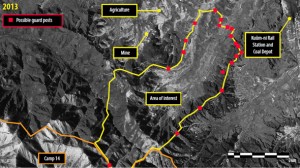This posting is part of the North Korea Revealed blogging series, published in the context of efforts to establish a Commission of Inquiry at the current session of the UN Human Rights Council (February 25 – March 22). Join the conversation through #NKRevealed.
Amnesty International is releasing new satellite images today that raise fears that the North Korean government is starting to blur the line between the country’s horrendous political prison camps and regular villages. This disturbing new development gives further fuel to a previous warning by a UN expert that authorities are turning the country into “one big prison,” and stress the urgent need for the UN Human Rights Council to establish an independent Commission of Inquiry.
We commissioned satellite imagery analysis from DigitalGlobe after reading reports about a potential new political prison camp. The original speculations were based on Google Earth satellite imagery from the fall of 2011. We were able to secure imagery from February 2013, allowing us to provide the most up-to-date snapshot possible of worrisome developments in a valley adjacent to prison camp 14.
Images reveal increase of control and security
The analysis of the Ch’oma-Bong valley, 70km north-northeast of Pyongyang, demonstrates that a 20 km perimeter had been established around the valley and its inhabitants, in addition to controlled access points, and a number of probable guard towers.
The analysis based on imagery from 2006 to 2013 tracks the establishment of the 20 km long perimeter, which has been fully established by 2010 and which borders on the Kaechun prison camp (Camp 14). In 2008, the first entrance to the valley with a checkpoint was observed, with expansion of the entrance in 2010, 2011, and in 2013 to include a guard station, new buildings, and an entrance arch. Analysts also found the construction of new buildings, which appear to house workers, likely associated with increased mining activity in the region.
The activity points to a tightening in the control of movement of the local population adjacent to Camp No. 14, thus muddying the line between those detained in the political prison camp and the valley’s inhabitants. This raises concern for the current conditions facing the population within the perimeter and the North Korean government’s future intentions with regard to them.
Will the Human Rights Council act?
In the context of North Korea, these developments are extremely worrisome. As described in my previous blog post, the government runs an expansive system of prison camps, in which tens of thousands of North Koreans suffer horrific abuses. As satellite image analyses commissioned by Amnesty International and others have previously documented, the prison camps are actually expanding. Just last week, the Committee for Human Rights in North Korea released a new analysis showing Camp 25 had recently expanded by 72 percent.
Our concerns are exacerbated by the complete lack of access for independent observers, making it impossible to further investigate the mystery of the Ch’oma-Bong valley. While a government representative recently claimed that observers such as Amnesty International and others have had access over the last 10 years, the North Korean government has in fact repeatedly denied entry to independent observers. (Amnesty International delegates last visited the country in the early 1990s).
These facts underscore the urgent need for the establishment of an independent Commission of Inquiry to comprehensively document the North Korean human rights crisis. Such a commission would establish an invaluable record of the abuses and put the authorities in a much-needed spotlight. Despite the difficulty of gaining access, the commission could rely on escapees and defectors, as well as novel tools human rights watchdogs have at their disposal in the 21st century. One just has to look at the impressive work of the Syrian Commission of Inquiry, which despite denial of access produces detailed accounts of crimes against humanity and war crimes, and which partially relies on videos and satellite imagery.
UN Human Rights Council member states have the unique opportunity to send a strong and unified signal to North Korean authorities that the world is not standing quietly by as they are turning the country into one big prison. We will know by March 22 if countries live up to these expectations. In the meantime, please join the campaign and add your voice by publicly speaking out against the widespread and systematic human rights violations in North Korea.

as AI Coordinator in Canada for the DPRK – this is challenging for us! What's the next step for us as coordinators? What can we do in our own countries to get our own governments to call for justice?
It somehow was expected to happen. Their system is designed to have a large military and police force in order to keep the country citizens constantly in terror. Otherwise it would not survive. The more people become aware of outside world the more forces are needed to oppress them and more prisoners end up in camps. It also provides cheap labour which helps to feed overgrown military force.
The North Korea has one of the world largest armies. I am not sure how efficient they would be if it came to a war. It seems that if offered good food and proper clothing, most of them could easily end up on enemy's side.
"Our concerns are exacerbated by the complete lack of access for independent observers". So, you don't have any proof, don't have any testimony from inside the country and you only can speculate on satellite pictures . "Radio Free Asia" isn't a good source, as the US, South Korean or Japanese goverment are neither, and speculations aren't useful when you are from a country which is in war with the one you are talking on. I hope AI starts using scientific methods instead of creating "war propaganda".